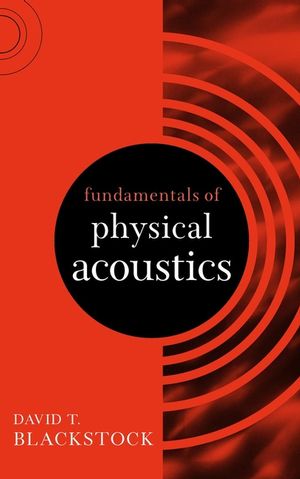Fundamentals of Physical AcousticsISBN: 978-0-471-31979-5
Hardcover
576 pages
April 2000
 |
||||||
AN AUTHORITATIIVE, UP-TO-DATE INTRODUCTION TO PHYSICAL
ACOUSTICS
Easy to read and understand, Fundamentals of Physical Acoustics fills a long-standing need for an acoustics text that challenges but does not overpower graduate students in engineering and physics. Mathematical results and physical explanations go hand in hand, and a unique feature of the book is the balance it strikes between time-domain and frequency-domain presentations.
Fundamentals of Physical Acoustics is intended for a two-semester, first-year graduate course, but is also suitable for advanced undergraduates. Emphasis on plane waves in the first part of the book keeps the mathematics simple yet accommodates a broad range of topics: propagation, reflection and transmission, normal modes and simple waveguides for rectilinear geometries, horns, inhomogeneous media, and sound absorption and dispersion.
The second part of the book is devoted to a more rigorous development of the wave equation, spherical and cylindrical waves (including the more advanced mathematics required), advanced waveguides, baffled piston radiation, diffraction (treated in the time domain), and arrays. Applications and examples are drawn from:
* Atmospheric acoustics
* Noise control
* Underwater acoustics
* Engineering acoustics
* Acoustical measurements
Supplemented with more than 300 graphs and figures as well as copious end-of-chapter problems, Fundamentals of Physical Acoustics is also an excellent professional reference for engineers and scientists.
Easy to read and understand, Fundamentals of Physical Acoustics fills a long-standing need for an acoustics text that challenges but does not overpower graduate students in engineering and physics. Mathematical results and physical explanations go hand in hand, and a unique feature of the book is the balance it strikes between time-domain and frequency-domain presentations.
Fundamentals of Physical Acoustics is intended for a two-semester, first-year graduate course, but is also suitable for advanced undergraduates. Emphasis on plane waves in the first part of the book keeps the mathematics simple yet accommodates a broad range of topics: propagation, reflection and transmission, normal modes and simple waveguides for rectilinear geometries, horns, inhomogeneous media, and sound absorption and dispersion.
The second part of the book is devoted to a more rigorous development of the wave equation, spherical and cylindrical waves (including the more advanced mathematics required), advanced waveguides, baffled piston radiation, diffraction (treated in the time domain), and arrays. Applications and examples are drawn from:
* Atmospheric acoustics
* Noise control
* Underwater acoustics
* Engineering acoustics
* Acoustical measurements
Supplemented with more than 300 graphs and figures as well as copious end-of-chapter problems, Fundamentals of Physical Acoustics is also an excellent professional reference for engineers and scientists.



